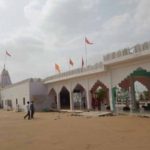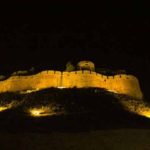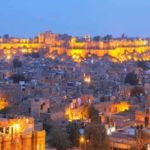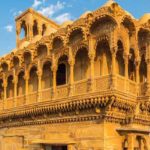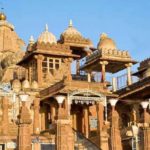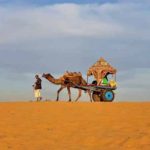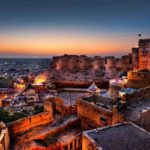15 Places To Visit Jaisalmer, The beauty of the sandy desert, along with the royal palaces and fighting camels of Rajasthan, is epitomised by Jaisalmer, the Golden Capital. In the midst of the great Thar Desert, this world-famous tourist destination is located. It also shares its boundaries with Pakistan, Bikaner, Barmer and Jodhpur, and acts as the administrative headquarters of the Jaisalmer district. This Golden City is just 575 km away from Jaipur, the capital of the state. The main sector that plays a key role in the district ‘s economy is tourism. The town was named after Rawal Jaisal, its founder, who ruled Jaisalmer during the twelfth century.
This Golden City is renowned for the folk music and dance forms of Rajasthani that are highly regarded in the global forum. On the occasion of the Desert Festival at Sam Sand Dunes, the most sensual dance style, Kalbeliya, is performed by indigenous tribes. This is an annual three-day festival held in the month of February. Tourists from far flung regions are drawn to the camel races, turban tying and the best moustache contests. In addition, the camping, bonfire and camel safari in the great Thar Desert are sure to give travellers visiting Jaisalmer an unforgettable experience.
For royal forts, havelis, palaces, museums and temples, Jaisalmer is also very popular. Jaisalmer Pride, Jaisalmer Fort or Sonar Quila is Jaisalmer’s most popular tourist attraction and is a World Heritage Site. Nathmalji ki Haveli, Salim Singh ki Haveli, Patwon ki Haveli, Manak Chowk, Jaisalmer Folklore Museum, Tazia Tower, Gadisagar Lake, Bada Bagh, Khuri Sand Dunes, Sam Sand Dunes, and Kuldhara are some of the popular tourist places to visit in Jaisalmer.
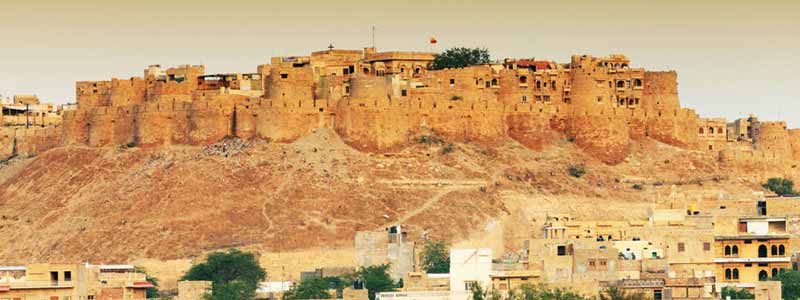
1. Jaisalmer Fort – For The Rich Rajputana Splendor
Jaisalmer Fort is built from the region’s golden-hued Jurassic sandstone, like most of the area, and the effect is enchanting. It looks like a golden sandcastle from a distance, emerging from the remote desert of western Rajasthan. But it is also a living fort, with a population of approximately 3,000 living within the complex.
In the state of Rajasthan, the Jaisalmer Fort is the second-oldest fort and the oldest continuously occupied fort in India. In the 12th century, the Rajput ruler Rawal Jaisal founded it on a hill. For extra protection during defence and war, the double-fortified ramparts and circular bastions are integrated into the spectacular architectural design.
Jaisalmer is on the edge of India, very close to the border with Pakistan, but it’s not really off the beaten track. It was at the crossroads of many major trading routes centuries ago, including the ancient Silk Road. In the fortress, rich merchants constructed intricately carved havelis, adding to the beauty and charm of the Golden City.
From the city, a paved road takes you up a ramp into the fort, through four giant gates to Dushera Chowk, presided over by the beautifully carved Maharawal Palace, the former monarch’s home. The palace has been converted into a museum and tourists can walk between the rooms decorated and tiled, and up to the top, the highest point in the fort that offers spectacular views.
The view from the Maharawal Palace, as well as other Jaisalmer Fort rooftops, reveals the labyrinth of narrow, winding lanes that honeycomb through this ancient house. Wandering around them is a pleasure and fun, letting yourself get lost. With many impressive Jain and Hindu temples, endless souvenir shops selling Rajasthani crafts such as puppets and textiles, guest houses and boutique hotels for every budget, residents share the confined space, cafes and restaurants, and, the fort museum itself.
Jaisalmer Fort is a UNESCO World Heritage site, part of Rajasthan’s group of six hill forts. But Jaisalmer is a living city that both retains the past and thrives in the present, unlike most other forts.
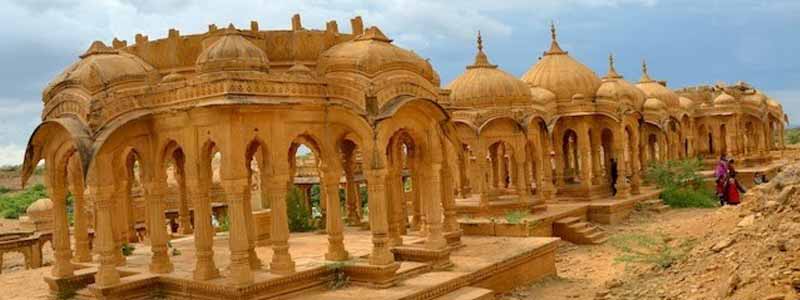
2. Bada Bagh – For A Royal Walk
Bada Bagh is a unique place near the city of Jaisalmer (about 6 km away) where you can find magnificent and breathtaking cenotaphs belonging to the Jaisalmer royal family members of the 16th century & later.
Bada Bagh is ranked as a desert garden near Jaisalmer & typically travellers come here from Sam sand dunes while going or coming back, as this site is on-route.
Most travellers come to Bada Bagh to take some fine pictures and even catch a beautiful sunset as you get one of the best sunset shots from here, (the best one is at the Sam sand dune sunset point)
Full information on the past of Bada Bagh, entry fees, what to see here, nearby attractions & hotels, etc. is given below. And check out our full list at the Jaisalmer Tourist Attraction.
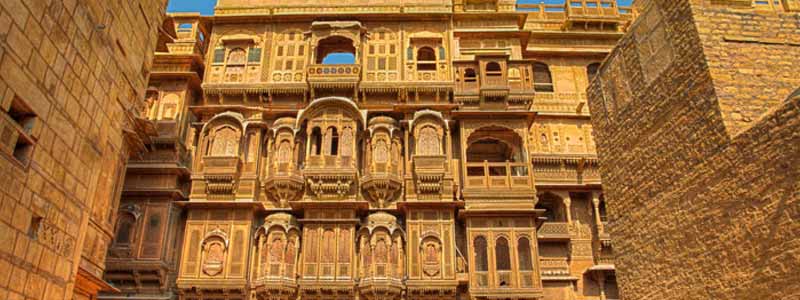
3. Patwon Ki Haveli – For Beautiful Carvings
The Patwon Ji ki Haveli is a fascinating piece of architecture and the most important one in Jaisalmer among the havelis. This is precisely due to two reasons, firstly because it was the first haveli erected in Jaisalmer and secondly because it is not a single haveli but a cluster of 5 small havelis. The first of these havelis, which was commissioned and designed by Guman Chand Patwa in 1805, is the largest and most ostentatious. Patwa is believed to have been a rich man and to have been a renowned trader of his time. He could afford to create separate storeys for each of his 5 sons and therefore ordered them. In the period of 50 years, these were completed. In the first 60 years of the 19th century, all five houses were built.
Often known as the ‘manor of brocade merchants’ are the havelis. This name was possibly given because the family dealt with gold and silver threads used in embroidering dresses. There are hypotheses, however, that these merchants made a large amount of money in drug smuggling and money-lending.
This is the largest Haveli and stands in a narrow lane in Jaisalmer. This haveli is currently owned by the government, which uses it for different purposes. In the haveli itself is located the office of the Archeological Survey of India and the State art and craft department.
Nevertheless, you will find a decent number of paintings and mirror-works on the wall even after these invasions and violence. Its gateways and arches are the other important features. On each and every arch, you will note individual depictions and themes. Although the entire building is made of yellow sandstone, the Patwon Ji ki Haveli main gateway is brown in colour.
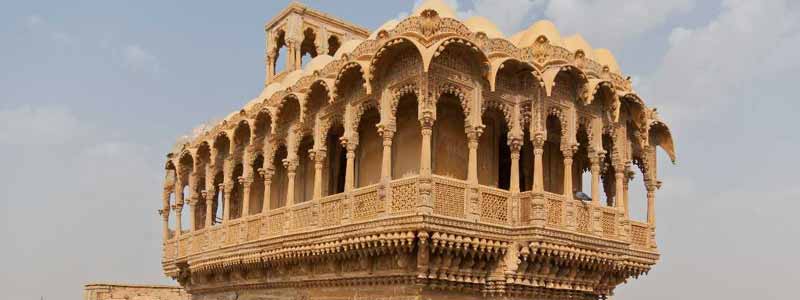
4. Salim Singh Ki Haveli – For Scenic Views Of The City
The Salim Singh Ki Haveli was built about 300 years ago in 1815 and was named after Salim Singh Mohta, its owner. This haveli was constructed near the Jaisalmer Fort, from the remains of an older haveli present here belonging to the 17th century. The Haveli was occupied by the Mehta family of Jaisalmer after a certain period of its construction, which was said to be the most powerful family of their time.
This haveli is best known for its unusual architectural design in which its roof, complemented by an elegant pavilion, was designed in the shape of a peacock. To make it more spacious, grand and taller, Salim Singh added two additional floors of wood to the original haveli. Jaisalmer Tuskers, which are made of sand and stone and have an appearance very similar to living ones, guard the gateways of this Haveli.
Its structure has 38 balconies, all decorated with imperial paintings in the Mughal style with their distinctive designs and walls. The front facet of the haveli is like the stern of a ship, which is also known as Jahazmahal. There’s also a ‘Moti Mahal’ inside the Haveli. This location was the one where royal dances were enjoyed by their owners. Designed in 1815 with a peacock-shaped roof and many balconies, the architecturally impressive house. Salim Singh ki Haveli is one of Jaisalmer’s most popular places and has been at the top of lists for being an incredible destination. It is situated in the heart of the city of Jaisalmer, close to Jaisalmer railway station. Jaisalmer ‘s numerous stately houses and havelis are a result of the fact that the city is an integral part of Rajasthan’s rich history. The Haveli is so magnificent, one of the most ambitious constructions of its time, that it even invited the ruler’s envy during its era.
5. Sam Sand Dunes – For A Thrilling Camel Ride
If you do not go for the Desert Safari, there is no point in coming to the Thar Desert. That’s why the Sam Sand Dunes in Jaisalmer are becoming the main attraction. This is the closest location in the Great Thar Desert where you can lose yourself. Sam has an extremely stunning stretch of sweeping dunes, with little to no vegetation. Of course, the fastest way to get here is on a camelback.
For your Rajasthan tours, join a camel caravan at Jaisalmer and ride along the spectacular crests and troughs. Enjoy the romance of isolation as your camel carries you deep into the heart of the Desert of Thar. Place yourself behind the horizon in the camp and feel the sun setting. Organize a bonfire at night with your fellow tourists and enjoy Rajasthan’s rustic and earthy music and dance.
This whole place becomes a cultural centre in the month of February / March. The Rajasthani culture as a whole is showcased by the desert festival held in the midst of these dunes. This annual festival, held with great pomp and display at the Sam Sand dunes in Jaisalmer, Rajasthan, is marked by open-air cultural extravagances, puppet shows, folk dance performances, camel races, competitions and general festivities.
6. Gadisar Lake – For Boating On Silken Waters
Gadisar Lake In the old days, it was the only source of water for Jaisalmer city. The Gadisar Lake in Jaisalmer, Rajasthan, a man-made reservoir, was built by Raja Rawal Jaisal, the first Jaisalmer ruler. In later years, the lake was reconstructed and renovated by Maharaja Garisisar Singh.
In the old days, it was the only source of water for Jaisalmer city. The Gadisar Lake in Jaisalmer, Rajasthan, a man-made reservoir, was built by Raja Rawal Jaisal, the first Jaisalmer ruler. In later years, the lake was reconstructed and renovated by Maharaja Garisisar Singh. The banks of Gadisar Lake Jaisalmer surround the artistically carved Chattris, Temples, Shrines and Ghats. The entrance to Gadisar Lake or Garsisar Tank is located to the south of Jaisalmer City through a magnificent and artistically carved yellow sandstone archway known as the Tilon-Ki-Pol. One can see unusual migratory birds stopping at the lustrous Gadisar Lake for a drink That reflects the picturesque sandstone banks’ mellow yellow; enjoy a boat ride on the lake or just sit on any of the Ghats and watch the yellow sandstone banks shift ochre hues with the setting sun, a lovely panorama that the world wouldn’t miss. During the yearly Gangaur festivities, the serene Gadisar Lake comes to life. The view from Gadisar Lake to Jaisalmer Fort is breathtaking.
7. Desert National Park – For An Encounter With The Wild
The Desert National Park, located in Rajasthan, 40 km from Jaisalmer, is counted as the largest park in Rajasthan State. In its contrasting image of being a barren desert ecosystem and at the same time being home to a multitude of migratory birds, this area offers an example. Since it is near Bharatpur, there are a whole range of birds that migrate to this area. Among the many that migrate to this area are a number of Eagles, Vultures, Buzzards, Falcons and many other predatory birds. One of the most popular birds found in this area is the Great Indian Buzzard. The region is a perfect place to explore wildlife that thrives in very harsh conditions and get to know and spend time in the midst of the beauty of a very different and harsh nature.
The Desert National Park is extensively protected by large areas of sand dunes. There are ancient salt lake beds that used to exist in this area a long time ago. They are packed with thorny shrubs and flora and fauna tend to be largely unlivable and uninhabitable in the topography of the area. However, flora and fauna of various kinds are found to flourish in different seasons in this area, although they are found mostly in the winter season. The best time to visit this location is in the winter and early spring, from November through March. This is the time when this area is visited by the highest number of migratory birds.
8. Amar Sagar Lake – For Blissful Views Of The Sunset
Amar Sagar is a lovely little lake cum Oasis, adjacent to the palace of the 17th century called the Amar Singh Palace. This palace was designed by Maharawal Akhai Singh in honour of one of his predecessors, Amar Singh. There are pavilions next to the palace, with large stairs leading down to Amar Sagar Lake. This haveli has been designed in the pattern of flats. The Amar Sagar is a five-story high Haveli and is renowned for its murals You will find beautiful murals painted with delicate efforts everywhere you go in this Haveli.
In the surrounding area, you can find several wells and ponds which have a royal air about them. In the complex itself, there is an old Shiva temple. This was created by Amar Singh because he was supposed to be an ardent follower of Lord Shiva, a destruction-related Hindu Deity.
9. Kuldhara Village – For Some Spine-chilling Mystery
In the Jaisalmer district of Rajasthan, India, Kuldhara is an abandoned and cursed village. This is one of Rajasthan’s haunted places and one of Jaisalmer’s popular tourist places, too.
It was once a prosperous village inhabited by Paliwal Brahmins who had migrated from Pali to the Jaisalmer area, founded around the 13th century CE. All residents of the village of Kuldhara and nearby 83 villages are believed to have left their homes overnight in 1825 AD, likely because Due to persecution by Minister Salim Singh of the Jaisalmer Province, or as a local legend says, of the declining water supply.
Salim Singh was the Diwan of Jaisalmer who was renowned for dissipation, according to legend. He focused his gaze on the beautiful daughter of the village leader. He also told the Kuldhara villagers that he would levy heavy taxes on them if his wish was not fulfilled. The Brahmins were very loyal to their beliefs. Instead of giving their daughter, the villagers left their homes and their belongings in fear of the Salim Singh, and ran away to a place no one knows to date. But they cursed the place before leaving, so no one would be able to live there again. The village remains deserted to this day and no one ever spends a night here.
It gradually developed a reputation as a haunted site, and the government of the state of Rajasthan decided to establish it as a tourist spot. The remains of 410 structures can now be seen in the village. Once, a team from the Paranormal Society of Delhi wanted to find out if this place is still haunted and spent nearly 12 hours at night in Kuldhara. They spotted strange behaviour in the village with their gadgets and equipment. When there was no one around, several of them noticed someone tapping their side. They also revealed their identities to certain spirits and they saw dark figures and movements.
10. Vyas Chhatri – For The Blessings Of Sage Vyas
Chhatri is located on Bara Bag Road, 01 km from Jaisalmer, opposite the Himmat Garh Hotel and close to rural huts. It is the cremation site of the dead bodies of the Brahmins of Pushkarana. Here, imaginative cenotaphs are created.
The cenotaph of Sage Vyas, the man who compiled the Hindu Mahabharata epic, the longest scripture in the world with nearly 300,000 verses, lies just north of the fort.
Ganesh, the god with an elephant-head and the son of Shiva the Destroyer, was dictated by the Mahabharata. Vyas Chhatri is also referred to as Sunset Point in the town as it offers you a wonderful view at sundown of picturesque Jaisalmer. The Sunset point over Sooli Dongri is a big hit with tourists and is certainly worth a trip to Jaisalmer and its adjoining areas if you want a bird’s eye view.
As the cremation ground of Bada Bagh in Jaisalmer is intended for the members of the royal family of the Bhatti clan, Vyas Chhatri is similarly situated in the area intended for the cremation of the Brahmins. The Vyas Chhatri is constructed of yellow sandstone with beautifully chiselled pillars, raised on a base. It is situated in the Brahmins’ cremation ground in the north of Jaisalmer Fort. Immaculate & detailed carvings, domes in the form of an umbrella and fine etching on the pillars warrant a serious visit. It is known as ‘Sunset Point’ as well. It is made even more gorgeous by the wonders of nature. It is best to be present during the evening at Vyas Chhatri to see the sun set when the orange light shines through the sand. Watching the sunset in its most beautiful form, the location is an ideal spot. From October to March is the perfect time to visit. Most of the guests come here to pay tribute to the great Sage and have a spectacular sunset view. You will visit it after paying the entrance fee.
11. Desert Culture Centre And Museum – For A Peek At Rajasthan’s Heritage
In Jaisalmer, the Desert Cultural Centre & Museum is located on Gadisagar Road. It is one of Jaisalmer’s popular tourist attractions.
The museum was founded in 1997 by Mr. N. K. Sharma. The Desert Cultural Centre and Museum beautifully shows Jaisalmer’s sculpture, craft and history. There is a large collection of traditional tools, mediaeval coins and cultural objects in the museum. This is a treasure trove of Rajasthani ethnic jewellery, crafts, weapons, and fossil wood. The museum is run by Jaisalmer’s Tourism Department and is a must-visit for history buffs.
In this museum, numerous musical instruments and costumes related to folk dance can be found. In the museum, you can also find costumes of former maharajas and maharanis. Here you can find kitchen equipment and culinary equipment, while the Rajasthani arts are displayed in the walls belonging to painters from different periods. Sculptures made from sandstone and terracotta are present, collected from different regions of Rajasthan.
Among foreign travelers, the museum is very famous for the traditional opium mixing box known as ‘Karal‘. These showpieces display the rich cultural heritage of the people of the Jaisalmer desert. It also has a small book store from which you can purchase literature about the town of Jaisalmer. The highlight of this spot is the hour-hour puppet display that takes place with English commentary throughout the evening. It is a delightful curriculum that can be enjoyed equally by both children and adults.
12. Tazia Tower – For Delectable Rajasthani Food
One of the main tourist attractions is Jaisalmer’s Tazia Tower. Tazia Tower will come to you as a welcome break if you’ve finished with the numerous Rajputana architectures scattered in the area. It is situated near Amar Sagar Gate in the excellent ‘Badal Palace’ complex. These were the former royal family’s residences. The Tazia Tower is a five-story building where each storey has its own purpose. There’s a balcony on each floor that is renowned for its individual designs. It was crafted by Muslim artisans and is based on the shape of the Tazia. In reality, Tazia is a replica of the Mausoleum of different Imams. They are made from wood, coloured paper and thermocol. It was gifted by the architects to the then royal patrons.
13. Khuri Sand Dunes – For A Night Of Fun And Entertainment
Khuri, famous for its sand dunes, is a small village about 50 km south-west of Rajasthan’s Jaisalmer. Khuri is less crowded and has an atmosphere that is more fun. But Khuri has avoided commercialization and the crowds that descend to visit the sand dunes to make a prominent mark on the tourist map. You can reach the Khuri Sand Dunes of the Thar Desert within 30 minutes or so from the village.
In Khuri, signs of growth are evident as more people discover it. Locals have also been swift to take advantage of the village’s growing popularity. The USP for many homestays in Khuri is to remain in houses made of mud and straw. Khuri tourists divided their sojourn into a village night and a desert one. A night in the desert provides a great atmosphere for star gazing. Bonfires accompanied by folk songs and Kalbeliya dance routines are popular to entice tourists.
For the amusement of travellers, camel races and camel polo are also organised. Khuri provides viewing points for watching the Demoiselle crane or the Great Indian Bustard if you are interested in birds or wildlife in general.
A trip to Khuri can also be paired with a trip to the Desert National Park (DNP), about 65 km north. The population of the DNP is one of the largest national parks in the country and consists of over 120 resident and migratory birds.
14. Nathmal-Ki-Haveli – For Witnessing Paintings In Pure Gold
This Nathmal Ji ki haveli was commissioned by Diwan Mohata Nathmal, the then Prime Minister of Jaisalmer, to serve as his residence. The design of this Haveli was commissioned by Maharawal Beri Sal. Hathi and Lulu, who happened to be brothers, were the architects of this Haveli. Regarding its building, there is a very interesting storey. It is said that the two brothers began to concurrently create various facets of haveli. There were no such methods in those days, which could keep track of continuity and thus had an odd shape when this building eventually arrived.
Barring that, in terms of grandeur, this haveli is still known as the best in Jaisalmer. Other minute specifics are worth appreciating. There are two elephants made of yellow stone, for example. In front of the main entrance, these life-size replicas were positioned so that it appears like they are protecting the Haveli Other than these, there are portraits on pillars and walls that are carved. These include, among other items, horses, cattle, and the representation of Flora. The most fascinating feature of this hasli, however, is the creation of modern facilities such as vehicles, fans, etc. It is said and believed that the Architect brothers often saw these things in their lives and engraved them with the mere support of their descriptions provided by people who had seen them.
The architecture of this haveli is therefore very different from that common in other parts of Jaisalmer. The workmanship of Jaisalmer havelis is an amalgam of the architecture of both Rajput and Islamic art imported through the desert from the traders’ caravan.
15. Tanot Mata Temple – For A Mystical Day Tour
This famous shrine, which gained nation-wide fame during the 1971 war between India and Pakistan, is a must-visit site in Jaisalmer. The temple is in near proximity to the Longewala boundary between the two countries and is dedicated to Tanot Mata, believed to be an avatar of Hinglaj Mata. Legend has it that no bomb that fell near the temple spread during the war when thousands of bombs were shelled, thereby shielding the locals and troops. The neighbouring museum, which contains wartime objects, can also be visited by visitors. The Border Security Force of India protects the temple. The area also boasts windmill rows that contribute to the area’s quaintness. Around 150 km from Jaisalmer lies the temple.

